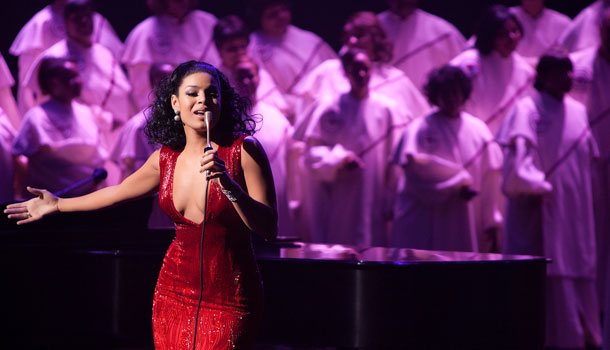
For R&B music in the mainstream, its been a topsy-turvy few years, and not because the music created was bad, but albeit the separation from its roots and having gradually been ensconced by the tempting cacophony of EDM and the re-birth of dance-pop. Even so, there hasn’t been a better year than 2013 to initiate its comeback.
With the array of winning singles and a small bin of LPs released, the declaration of R&B’s return is here. At the helms of artists and artistes looking to bring back its level ardency and genuine lived and learned recollections, (heartbreaking and uplifting), fans of this genre can certainly exhale some relief.
As some may already know, hits of the past sound as good today as they did in 1983 or 1996. Yet, the traces of such tracks as “Can’t You See,” “Cupid,” and “Twisted” are hard to come by when, according to MTV, Rihanna and her worldwide smashes of “We Found Love” are apparently R&B’s greatest representation, despite the music doused in clubland innovation.
On the underside of those booming beats, when “real R&B” was created, it was appreciated by those that sought for its existence, finding reassurance in the glorious soul and mellow funk streams of geniuses like Raphael Saadiq, the calm beauty of Angie Stone, and fulfilling confidence of Sharon Jones and the Dap-Kings. In 2003, Leela James, in her love letter to the original sangers, catechized in “Music”: “Can’t we just put them thongs away…I can’t even turn on my radio, without someone hollering about a bitch or ho. Right now, I’m missing music…”
Her tribute was released two years after a wave of returning artists and newcomers were all about expression through the original foundation. Though Lucy Pearl, City High, Sunshine Anderson and Tweet all earned recognized hits, longevity was short-lived. So while “real R&B” continued to be produced by the likes of Teedra Moses and Avant, it was never as cradled in the limelight as the careers of Usher and Beyonce were, leaving some to wonder, if the foundation had officially been rejected by new standards of hit-making.
In 2013, the resurrection is audible, and while faith has been restored by known acts, fans won’t have to scour as hard because the treasure trove has been opened. Your ears couldn’t be more excited to experience the return of quiet storm, the current generation embracing the classics of yesteryear (Mario’s “Somebody Else”, K. Michelle’s “V.S.O.P”, and Kanye West’s fantastic “Bound 2” with the legend Charlie Wilson), and still introducing rhythm and blues as a genre that’s as equally multifaceted as it can be traditional.
From the experimental perspective, 2013’s students of the school that rock ‘n roll and Motown built are taking the adage of “being different” to levels of utter creative freedom, you’ll be crazy to not feel inspired by their capricious approach. Janelle Monae’s The Electric Lady is our Sign ‘O the Times 2.0 (a major compliment). Funk, R&B, be-bop; with a little eccentricity to boot, she epitomizes how the genre excels at being so kaleidoscopic, as does Dawn Richard with her Victorian contributions.
For the contemporaries, say what you will of Chris Brown, his otherwise genteel vocals continue to remind us of his talent, especially on tracks worthy of it, like his “They Don’t Know,” a duet featuring the voice of a posthumous Aaliyah. Ciara also has released the most complete album of her career; Sevyn Streeter is highly promising if she treks on with ballads like “It Won’t Stop,” and Miguel is the reigning new Prince of music for sensual musings. Late last year, Solange dazzled with her tropical, new wave confession of “Losing You,” and despite a take-no-prisoners reputation in social media, Keyshia Cole is a songbird of high caliber. Albums-wise, efforts have been compelling from Alicia Keys, Kelly Rowland, Tamar Braxton, and Fantasia showcasing an uncompromising loyalty to the genre, even with the occasional push and shove of rollicking sounds.
For a while, R&B did lose its way, and instead chose to follow the footsteps of seedy hip-hip. Even a playboy like Trey Songz participates in great music, but you would never know and pass on giving his album a chance because of brazen singles like “2 Reasons” and his guest spot on Meek Mill’s artless “Face Down.”
Like Songz, suddenly talented singers like Brown were itching to simultaneously rap and record lascivious tracks that would make Jodeci take a second listen, wondering if the students had become the master. The genre was lost. Threatened by the popular impact of dance, pressured by hip-hop to be more disrespectful than seductive in the name of sex sells, R&B was a shadow of its greatness.
Grammy winning artist The-Dream denounced the state of this once dominating platform (as per The Guardian: “We love Adele singing [soul], but Beyonce singing it? No, the tempo’s too slow, gimme the club hit”), the bigger question may be, are the artists themselves doing their part? And from the outside in, we can sympathize. Does that “real R&B” pay the bills? Can it co-exist with the new “ratchet” and “turnt up” culture that just won’t quit? New artists like Luke James, Bridget Kelly, and many burgeoning others are trying, though Robin Thicke, adored by Black audiences as that White boy with soul, finally got mainstream love with “Blurred Lines.” Certainly ‘70s influenced, but without a doubt a pop record.
And it is like pop music. The way admirers of Lana Del Rey salivate over her cinematic videos and grandiose lyrics, prefer her over Selena Gomez’s sound primed for prom tracks, R&B is not all created the same–and it shouldn’t be. For all of K. MIchelle’s luxurious vocals on velveteen tracks, she can be raunchy as R. Kelly, and the new alliance of TGT (Tyrese, Ginuwine, and Tank) are inexplicably chucklesome in the way of those male groups of the New Jack Swing era were–with top ten hits in spades.
Perfection is definitely not being asked here, and a modern mindset isn’t literally begging for the new kids to remake “Tell Me Something Good;” but yes, a little balance of all of R&B’s layers is being asked. Interestingly, an artist going back to the basics to R&B can still be heard today. John Legend’s Love in the Future is a prime archetype of the kind of love paeans Brian McKnight won us over in 1998 with a dash of Isley Brothers charm. Rhythm and blues is still present, and since we yearned for its return to prominence, as the necessary audience, let’s start giving it the attention it merits.
———-
Follow C. Shardae Jobson at @lavishrebellion
Image Credit: Vintage Soul Singer via Shutterstock



